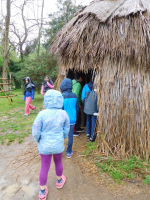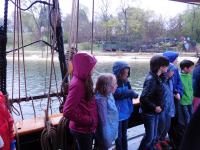I was surprised on Monday afternoon when June brought home the sheet of paper indicating I was a chaperone alternate for the field trip to the living history museum in St. Mary’s City the next day. I’d checked off the chaperone box when I filled out her permission slip—Beth and I agreed one of us would go but we hadn’t worked out which one of us. And then I got an email saying there were more people who wanted to chaperone than slots and it was a busy week for Beth because CWA is on strike at Verizon, so it seemed just as well.
However, the email said you could show up at school and see if there were any last minute openings, but I wasn’t planning to do that. In general, I prefer to know how my day is going to unfold well in advance. The fourth grade will be taking another field trip to the Chesapeake Bay later in the school year and we’d have priority for that trip if we sat this one out.
But then the paper June brought home Monday seemed to indicate they actually wanted people to come to school and see if there was space, so I decided I’d pack a lunch and bring the $10 admission fee with me when I dropped her off at school, just in case. June really wanted one of us to come and I thought I should make an attempt, though I didn’t expect anything to come of it. I had work, but no deadlines until the following week, so it was possible for me to go.
The time students were supposed to arrive was stated in different communications to be, variously, 7:30, 7:40, or 7:45. We aimed for the middle and got there just before 7:40. We saw June’s English/Social Studies teacher in the hall on our way to the cafeteria where the kids were gathering, and she said she thought there would be room on the buses because three fourth graders have recently transferred to other schools. And then the teacher with the clipboard taking chaperones’ names and cell phone numbers and collecting money said in addition one fourth grader was absent, so he also thought I could go.
I texted Beth “Looks like I’m going on this trip,” so she’d know where I was.
Knowing my aversion to spontaneity, she texted back, “You are a very good mom.”
So I settled in to wait with June and her friends in the cafeteria. The buses didn’t arrive on time, so we didn’t actually get underway until almost 8:30. The five fourth grade classes were split across three charter buses and there was a little confusion about where everyone should sit, so I wasn’t convinced that I was really going on this field trip until the bus was in motion and I was still on board.
The kids were excited to be on a bus with plush seats, a bathroom, and best of all, several television screens. June and I sat in the last row of seats, just opposite the bathroom, with her friends Zoë and Evie in the row in front of us.
Shortly after we got underway The Lion, the Witch, and the Wardrobe started playing. June and I read the Chronicles of Narnia last summer and fall and at first she seemed excited to see it, even though she was lukewarm about the books. But the sound was not turned up very high, so her attention wandered. I don’t think I could have followed if I wasn’t familiar with the story—but having read the series over and over as a kid and once aloud to each of my kids, and having seen this adaptation about five years ago—I am very familiar. I can’t read on moving vehicles without getting sick and I was wary of putting on my headphones and thus missing any announcements or instructions so the diversion was welcome. June went back and forth between watching the movie, reading a Dork Diaries book, talking and playing hangman with Zoë and Evie and looking out the window.
We arrived at the St. Mary’s historic site around 10:30. It had been raining when we left and I’d been hoping it would clear up while we were on the bus, but it was still gray and drizzly when we got there. In case you or one of your kids hasn’t been a fourth grader in Maryland, St. Mary’s City was the first English settlement in the state and it was also the first capital of Maryland. All the fourth graders in our county study its history and culture for much of the year and then visit it in the spring.
We started with the Yaocomaco Indian village. There were several houses made of bent saplings and grass, with beds and household tools inside. The guide pointed out a woven shelter in the garden area where boys had to sit with a basket of rocks to throw at garden pests. I asked June if she’d like that chore this summer and she said no. There were no actors in the Yaocomaco village, but apparently current members of the Piscataway tribe do occasionally act out scenes there.
From there we moved to a tobacco plantation where we met an indentured servant who was making mint tea in the kitchen of the planters’ house. She explained you could tell her master was prosperous because he had a two-story house with glass windows and a wooden floor. The guide took us out to the garden, which wasn’t planted yet but explained that all food and medicine would come from the garden, as it was “the CVS of the seventeenth century.” We saw some livestock around the house, mostly cows and chickens, though I caught a glimpse of a pig in the woods.
Our next stop was the town itself where we visited a tobacco barn, a general store (“the Walmart of the seventeenth century”), and a print shop (“the Staples of the seventeenth century”). At each stop we met actors playing the parts of a farmer, another indentured servant, a storekeeper, and a printer. I asked June as we walked from one building to another if there were any slaves in St. Mary’s. It was a tobacco farming community so I thought there must have been. June was well informed on the point, “Not until the eighteenth century,” she told me.
As we moved from building to building, a few kids were picked as volunteers to shape an axe blade, to use the counting board to calculate a shoppers’ bill, or to ink the letters on the printing press. At the inn, our guide picked kids and told stories about reasons why they were staying at the inn—to appear in court was a popular one—and then had them lie down on the bed. Evie was being tried for witchcraft and she could be heard later in the day declaring, “I’m a witch!” with some enthusiasm.
When it was Zoë’s turn the guide was telling a story about a man travelling to meet his girlfriend who would soon arrive by ship. After she’d referred to Zoë, who has short hair, as “he” and “Joey” a few times, I started to wonder if I should correct her. I was standing close enough to lean in and whisper. But I wasn’t sure if Zoë would appreciate that or find it more embarrassing. While I was equivocating, the kids started to giggle, and when they did the guide shushed them and said to Zoë, “You’re a good sport, aren’t you?”
“Yes, I am a good sport,” Zoë said. “I’m also a girl and my name is Zoë.” Her tone was just right, not disrespectful, but self-assured. I could not have pulled that off in fourth grade.
We took a break then to have lunch in the bus because it was still raining and we watched a little more of The Lion, the Witch, and the Wardrobe as we ate. I hadn’t eaten much breakfast, thinking I was just dropping June off at school, so I was pretty hungry by that point. My apple and container of vanilla Greek yogurt didn’t seem quite sufficient, but it was what I had. Worse still, the pint of bottled water June and I were sharing was definitely not enough for a whole day. I’d thought there would be water fountains somewhere, but there were no water fountains in the seventeenth century.
Our last stop was the Dove, a recreation of one of the boats that brought supplies to the colonists and carried tobacco back to England. June was most excited to see this as they had studied the boat. After touring the boat itself we went to various stations on the dock where a block and tackle and different navigational tools were demonstrated.
At the very last station, the guide asked for anyone who hadn’t volunteered yet, and June, who’d patiently raised her hand at every station and two other girls who were also never picked seemed about to get their turns. The artifact was a “honey bucket” to carry human waste to be thrown overboard. The guide explained its use but never asked the volunteers to do anything (though at this station I’m not sure anyone would want to demonstrate). When the group was dismissed, one of the girls lost her temper, asking, “Why did you ask for volunteers?” but there was no answer. June was a bit put out, too, but she didn’t let it spoil her mood.
We all trooped back to the bus. We’d been running a half hour late ever since we left the school and then around forty-five minutes into the ride one of the buses overheated and ours stopped, too, in order to stick together. We were stopped about twenty minutes, so we were almost an hour late returning to school. There was another movie to watch, Cloudy with a Chance of Meatballs. By the end of the day the bathroom on the bus was starting to smell like a honey bucket. I was sorry to be sitting so near it and I was also getting dehydrated and headachy and I was hungry, too.
We went into June’s school to fill our water bottle before walking the mile home, but I couldn’t shake the headache, so instead of making black bean and spinach tacos for dinner as I’d planned, I just heated up a vegetarian hot dog for June (she got herself some strawberries), ate some cottage cheese straight out the container, told Noah to make himself something for dinner, took a painkiller and went to lie down for a while.
Eventually I felt well enough to read a chapter of Harry Potter and the Goblet of Fire to June on the porch while we waited for her ride to her Girl Scout meeting, but the family who usually drives her to Girl Scouts forgot so she missed the meeting.
This seemed par for the course as it had been a day of the unexpected, both good and bad, but I was glad to have spent part of it in the seventeenth century with my favorite lass.



